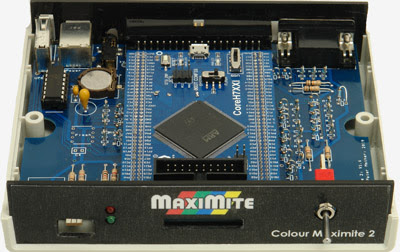Après avoir passé une commande pour le module processeur à base de STM32H7 chez
Waveshare ainsi qu'une autre commande pour le circuit imprimé directement chez l'éditeur de la revue australienne
Silicon Chip, j'ai reçu ces deux éléments de base quelques jours plus tard :
Il n'y a plus maintenant qu'à se procurer l'ensemble des autres composants à placer sur le circuit imprimé principal pour être en mesure de démarrer la construction de cet ordinateur fort prometteur.
Parce que, comme il est indiqué sur la couverture du magazine ci-dessus, il s'agit d'un ordinateur que l'on peut monter soi-même, certes, mais surtout que l'on peut programmer soi-même. Même s'il s'agit du langage Basic qui est utilisé ici, la puissance de ce langage adapté à ce type de matériel (j'en sais quelque chose, j'ai eu l'occasion de tester les versions précédentes sur des processeurs pourtant moins rapide) offre un potentiel d'expériences incroyables, notamment dans l'univers de l'embarqué.
Avec ce type de matériel, nous sommes loin de la culture de l'ignorance perpétuelle telle qu'imposée depuis des décennies par microsoft (à son unique bénéfice), mais bien d'un matériel en mesure de servir le potentiel créatif de tout un chacun. Au jeune qui souhaiterait se lancer dans l'aventure, qu'il ignore les programmes archaïques et propagandistes de l'Education Nationale, et qu'il commence donc par quelque chose d'un peu plus sérieux et utile que ça :
 |
| Exemple de robot et de son langage de (non) programmation associé que l'on retrouve aujourd'hui dans les programmes de l'Education Nationale. |
Au début des années 80, il existait le langage
Logo, utilisable sur une base matérielle présentée sous la forme d'une tortue :
J'ai du mal à imaginer les générations de programmeurs de talent qui ont fait de la france la première puissance informatique mondiale. Bien au contraire, mis à part quelques ingénieurs de haute volée officiant dans des domaines extrêmement pointus tel que l'avionique, le pays est devenue une colonie numérique, occupée par les puissances étrangères jusqu'à aujourd'hui majoritairement américaines, très prochainement Chinoises!
Heureusement, en ce qui me concerne j'ai débuté en assembleur sur Z80 puis en basic sur ZX81. Cela n'inscrit pas du tout dans l'esprit le même rapport à la machine. Cela ne m'a pas réussi professionnellement, mais au moins cela me permet d'appréhender le monde technologique qui m'entoure ainsi que la propagande désastreuse et bien évidemment mensongère dont en font les politiques intellectuellement corrompus!













